| |
Select
Aquatics Of Erie, CO. |
|
|
|
|
|
|
|
| |
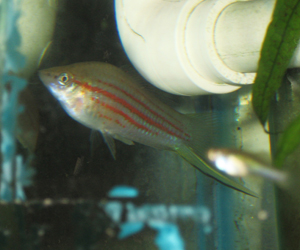 |
|
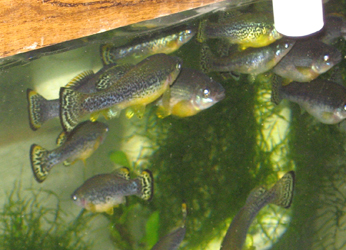 |
|
By
watching our fish we can tell if a
problem may be brewing. Fish that are
hiding when normally out in the open,
or are hovering near a heater or filter
outlet could be an indication that there
is a problem starting, such as with
this male X. alvarezi or
this group of
I. furcidens. |
 |
|
|
|
The fish are hiding in the plants when
they normally do not - This generally reflects a recent
change in the conditions in the tank
that you will need to address.
This may mean that a water change
is due, and a 20-50% water change may solve the problem. You may
see some
clamped fins as well at
this time, if not, and you do nothing, clamped fins and a
disease outbreak
may be in the works. I
would not add salt at this
point, but if a water change, followed by a good
feeding does not solve the
problem over 24 hours, I would then
siphon clean any substrate and
generally clean any areas that may conceal
mulm or decaying organic
material in the tank. I would then
add from ˝ to a full medicinal
dose of salt if conditions do not improve. (1 tablespoon per each 5 gallons of water).
Some who keep
non salt tolerant
plants may decide to use other
remedies, or removing the plants before treatment, as salt will
negatively affect many
plants. Keep an eye out for any
developing spots,
changes in skin texture,
fin cloudiness or
tufts of fungus
anywhere on the fish.
The fish are breathing at
the surface of the water - This usually indicates a
reduction of oxygen available to the fish for some
reason. With a reduction of
aeration, or an
increase in temperature,
oxygen levels decrease. Oxygen availability increases as
the water temperatures goes
down.
Immediate addition of an airstone should be done until you come
to a more permanent solution,
and the addition of the airstone
may be necessary for the long term.
The most common other causes of
a reduction in oxygen are
overcrowding, or a bacterial bloom from accumulation of excess
organic waste within a tank. Keep in mind that
plants use oxygen when they
are not processing light, so a tank
containing plants,
but whose light is not working,
can also experience reduced available
oxygen. The amount of aeration and water movement in a
tank that was fine for say, 5 fish that were 1
inch long may not be suitable for the same fish grown to 1.5- 2
inches, as larger fish
require more oxygen
while excreting more waste. And the
waste produced is primarily through respiration, not the release
of
feces and
urine.
The
fish are all together up in the corner- This is more
than simple lack of oxygen available to the fish, and requires
closer
observation to determine
the cause. Are the fish clustered near the
filter outlet? Or
near the heater? Or across the tank from the
heater? Or near an airstone or source of air? Are they in a group away from a
certain portion of the tank that may be dirty or in need
of cleaning? Could the fish
simply be avoiding the aggressive behavior of another fish? A
20- 50% water change may solve the problem.
Check for appropriate
temperature, insure that aeration is sufficient, and clean any dirty
areas of the tank, particularly under rockwork,
areas not easily seen and
the filter medium. Collection of waste could lead to an
anaerobic area in the substrate, causing the release of
toxic substances into the water. Lastly, if necessary,
look for any
aggressive fish that may be harassing other fish in the tank.
See
"One fish is picking on another
fish" below-
The
fish are jumping out of the tank- Some fish, such as
most killiefish, will routinely jump out of a tank, and the
tanks they are
kept in should
always be covered. Some fish will jump out of a tank
occasionally when the tank is overcrowded or the conditions are
not
to their liking (Swordtails). Most fish will not jump
out of a tank, but all fish may jump out of a tank when first
introduced, or when conditions
are new or unfamiliar. For this reason all tanks should be
covered when fish are first introduced. For fish not usually
known for jumping,
a
surface covering of riccia or other surface plants may be enough
to discourage jumping. However, fish can be prompted to
jump with
deteriorating
water conditions,
temperature that is
too warm or predators /bullies in a tank that will chase or
harass other fish. Keep
in mind that if a fish is determined to
jump, they will find any spaces or holes available to them.
(They have nothing else to do), so a
covering to prevent jumping must be complete
and secure.
One fish is picking on another fish – When this is
occurring. I pull the victim, if they are injured or weakened, and
move them to
a tank of their own
to recover. I will often add a medicinal dose of salt (1 tblsn
per 5 gallons) if I see any wounds. Then I try to figure
out what is going
on – Is there a pair chasing others away from a spawn? Or is
this bully a fish that needs to be moved? I will then pull the
fish doing the chasing,
and put him into a large net or a breeder to break his spirit
and calm him down, explained in next paragraph. The
focus is on the injured fish so
they recover, and when feeling good enough, I will often return
the victim fish to the tank when healed, with
the bully isolated, and give
that fish a chance to reestablish itself in the community.
This experience is with livebearers- the next solution may not
work for larger fish that may be more aggressive by nature. Put
the bully
into a large net, which is then hung in the same tank. He
is still in the tank and water that is most familiar, but he
can’t chase or bite
anyone. Depending on how
determined to be nasty the fish is, I will keep the bully in the net for 3
days to two weeks, and this will often
stop the dominant behavior. After being in a
submissive position for a period of time, in full view of the
other fish in the tank, this changes
the dynamic of the tank enough (depending
on the species of fish we are dealing with) to start a new
forging of heirarchy in the tank.
If the aggressive fish does not respond
to those efforts, I will then move the aggressive fish to
a different tank with a new set of tankmates,
that may be larger or not prone to being
bullied.
The fish are all on the
bottom – When you see this, it is often over an issue with
temperature or
water quality. You will need
to
figure out why this has occurred once
the fish are comfortable, but a quick 25%
water change,
correcting the temperature gradually if
necessary, should perk them up.
Then look into any possible temperature,
filtration or aeration
problems. You may decide to add a half
or full
medicinal dose of salt to
help guide them back to normal, comfortable conditions if they
do not show quick improvement. With air
problems, fish generally
collect at the top, and when fish are on the bottom it is
generally due to water quality, that can also be a foreign
substance having been
introduced into the tank.
The fish are more active than they should be – Most
of the time this is because the
temperature has risen past where
it should
be. Immediately
check the temperature, and if too high, turn off the heater and
light, and gradually add a 5-10% water change of colder water
to bring the temperature down.
Do not bring the temperature down more than 2-3 degrees. Some
fish often do not survive a temperature
drop greater than that in a short
period of time. Then increase the aeration
which both brings up the oxygen level in the warmer water, and
puts room temperature air
into the tank to also help bring the temperature down.
I have heard some say that these riverine livebearers in
particular can handle wide temperature swings in the wild, and
that may be true.
However, I have transported
fish to functions to find that temperature swings of greater
than 2-3 degrees in a short period will stun some
of these species. The Alfaro
cultratus, for example, is prone to this. Consistency works best
with most of these species.
Other causes for
hyperactivity could be a
pair guarding eggs that are chasing tankmates away from their
spawning site, or a fish that
has
become aggressive, who may need to be
removed or isolated.
The
fish’s color is all washed out- Not all fish will
hold on to their color when stressed, and all fish will show
some deterioration
of color and markings when in less than optimal
conditions. It has been said that "Every fish looks beautiful when well
cared for".
The
Odessa
barbs here will totally wash out, and can take up to 12 hours or
so to get their color back after being stressed.
The goodeids generally
hold on to their color, but most fish will show some loss of
color and markings when threatened or disrupted.
If
the fish appear suddenly to have lost their color, check the
temperature first to
make sure it is what it should be. If that is OK,
consider any recent
changes to the tank (A decoration? Something put into the
tank?), then do a 50% water change, and lower the
amount of
light - lower light
is always calming for fish. If that does not apply, then I would
clean the filter and siphon clean any
gravel in the
tank, then do a 30% water
change. I would not do more as the fish are weakened, and you
want the change to do the job without being a
stressor by itself. Many fish
will also wash out when kept in a tank with light colored or
bright gravel. The Odessas, for example, when kept
in a tank of light gravel with
with moderate to high illumination will totally wash out
and not regain their color until conditions are improved.
This leads to short,
stressful lives for the fish, even though all other conditions may be perfect
for them.
Fish do
well, but only live a short time- A few issues can be
in play here. Fish do best in water they are
fully acclimated
to, which
for many of the
livebearers here can take more than one generation. Fish received
as adults that were raised in water qualities different
from yours will often
experience a shortened lifespan. This is why when you do receive
fish from someone, your first efforts must be to
obtain fry that were born
in your water - those fish will live closer to a full lifespan,
often with better overall color and health, and are the first
step toward a colony that will
do well for you. See the article
"Fish Adjustment".
Another issue is that
many fish that can be maintained over a wide range of
temperatures will live longer or shorter lives, depending on
your aquarium
temperature. Warmer temperatures maintain fish with higher
metabolism, and they will not live as long as fish kept in
cooler
temperatures. Those kept
cooler will also grow more slowly, live longer, and often
achieve greater overall size than those raised at warmer
temperatures. The
swordtails here can be kept this way. Natural temperatures for
most swordtails is closer to 72 degrees, yet the
fishkeeping hobby has routinely
kept them much warmer, at 78-80 degrees. they will grow faster,
but not live as long, or get as large.
Fish are also greatly affected by conditions that introduce
stress, and a fish living a healthy life may pass prematurely
due to stresses
that were part of their lives,
but that you did not recognize or address. The
Odessas kept in a bright tank is one example. Fish
routinely dealing with tankmate
problems or water quality
that is inconsistent or often near
the unhealthy end of the spectrum
may experience shortened lifespans.
Keeping social or schooling fish by themselves can also be
stressful, leading to a shorter life.
There is much we do not
understand about what goes on in their tiny but complex minds,
and assuming "they will be OK" when a less
than ideal situation presents
itself may be a big adjustment for them, and can come with
consequences.
|
 |
|
|
| |
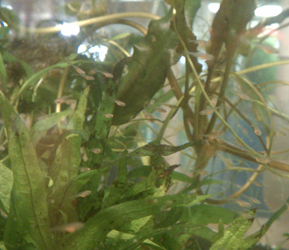 |
|
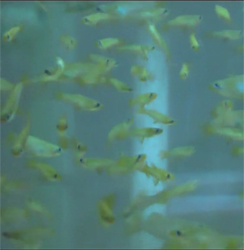 |
|
I
enjoy the challenge of breeding the fish
and raising their fry, and no longer keep
anything I am not actively breeding. When fish
breed for you, you know that they are in their
best health. On the far left are 9 day old
Odessa barbs, and young
Alfaro cultratus are
near left.
|
 |
|
|
|
There are new fry in the
tank - Besides being eaten by tankmates, new
fry also cannot
compete with the adults in the tank for
food.
As well, fry food needs to be
specific in size with a higher protein content, so new fry
can put on growth when they most need to do
so. New fry should always be
caught and put into either a tank of their own, or even better,
put them into a large net breeder in the same
tank, in the water they were born in.
That will ensure your greatest odds of success. Many breeders
will also keep lights on 24/7 when
raising new
egg
layer fry so they will grow most quickly. This requires a
late evening feeding to get them through the night. |
 |
|
|
| |
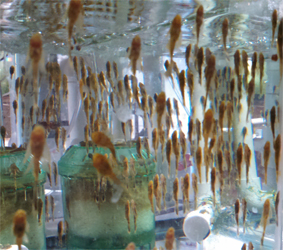 |
|
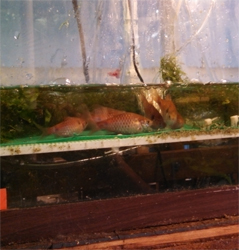 |
The best
part of breeding fish is that many will
breed easily with consistent, appropriate care, and
without much extra effort. The
Swords and Goodeids
are generally that way. But some species are far more
challenging, and there is a small or a large puzzle
waiting for you, depending on the species you choose
to spawn, your setup, and your own experience, time
and level of commitment. Both the
Green Dragon
plecos and the
Odessa barbs require special
setups
to breed and harvest the young, with some manipulation
of water quality. More information on breeding these
species can be found here for the
Odessa
Barbs,
and here for the
Plecos. |
 |
|
|
|
Troubleshooting Breeding Problems
The fish aren't breeding - Many fish, such as some of the
livebearers, will breed easily,
and their not breeding indicates
a fundamental problem with the
way the aquarium is
operating. With most Livebearers, if the
fish are healthy, they should breed.
(The swordtails,
guppies, etc.) Many other types of fish available in the hobby can be
bred, some more easily than others, when
attention is paid to 7 factors:
1. Make sure you have a
pair. Sounds obvious, but with some species is an easy mistake to make.
2. Make sure they are
old enough to spawn. Many of us fail trying to
breed fish that simply aren't
ready.
3. Put them into a tank
large enough so that distractions, aggressive tankmates and
space to feel at home are not an issue.
4. Provide
plants,
hiding places, rockwork, substrate, caves,
light or darkness,
aeration, water movement, whatever type of
environment the species has required to breed by others,
from doing research on successful efforts from books and
internet.
5. Ensure that
water
qualities are appropriate. Some species need to have their pH
brought down for them to breed, some
species
require harder water, some softer if they are to breed, though
they may survive otherwise in different qualities.
Research the species and efforts by others well, since there are
many forums and sites available today on the internet.
Try to
learn from other efforts, particularly if they were successful
at raising up the fry. Keep in mind you may need to create
an
entirely new way that will work better for you. Most research I
have done has been a start, but success came from
developing
a way of doing things that best met my setup and resources.
6. Increase frequency and
quality of feedings for at least 2 weeks previous to spawning,
providing live and
frozen food if
possible to
the breeder adults.
7. Provide excellent
filtration and water quality.
Then be patient. Sometimes weeks or months patient.
With many species,
breeding may
happen following heavy water changes, or after the sexes have
been separated for a period
of time, and
occasionally switching males will do the trick.
Read all you can
find, and ask questions! Often, learning how to best
breed a fish and raise their
fry is a repeated process, where small improvements are made with
each effort.
If your tanks are exposed to natural light, those cues may
trigger the fish's need to breed seasonally. Over half of the
fishroom
here does this.
Goodeids breed from April to October,
plecos from October to
February, swords from March to
October, etc.
Occasional spawns may occur
during the other parts of the year, but it is very infrequent.
Trying to spawn some fish off season
simply will not work,
regardless of the conditioning and environment you provide them.
With one fish here, they breed during the
week previous to the full moon.
No amount of putting heavy, egg laden females with males will
produce a spawn, unless it is during
that calendar window. Without
knowing this, you would think it is a very difficult fish to
breed, but they will spawn readily when the
conditions are right.
With a species of Synodontis here, it took over a year to get
them breeding at all, then another 18 months to get the
effective
harvesting of eggs worked out.
Then, egg batches were infertile for over a year. At about year
3, successful batches of eggs
were hatching, but the
microscopic young turned out to be quite fragile, and cannibalistic! Full batches are still not
being
produced, but improvements are
being made with each new batch. Each obstacle up to this point
has been fixed by changes
to the
water quality, following spawnings
on the calendar, making small changes to the
setup, etc., and each change was
often discovered by trying
other ways that did not work. Not all fish are as
difficult, but all species require some patience and
an opportunity to
do some reading and research for the greatest success, and best use of
your time. Then write everything
down! All
the breeding notes on the
Odessas, the Plecos,
the Synodontis and others will all be
made available to hobbyists
in the
future. Most of that information is already published at this
site, linked from the previous sentence.
Often, the problem is not getting the fish to
breed, but raising
their fry. The biggest obstacles to breeding a species
may not be
the breeding at
all, but the experimentation and various approaches it takes to
successfully harvest the eggs, hatch them, and
raise up the fry past
sexual maturity. Many fish will lay hundreds or
thousands of eggs. But it may take dozens of spawnings
to refine the harvesting of the eggs or fry, achieving an
appropriate hatch rate, and raising up what can sometimes be
microscopic and fragile fry.
The enjoyment of raising up beautiful, exotic fish that were
once nearly invisible to the naked
eye just cannot be explained! For
tricks and techniques to raise tiny egg layer fry, see the 5
page section on
Breeding the Odessa barbs. The process I use there,
for example, can be used to breed many pet store species of
barbs,
rasboras, tetras and danios.
Please do try to
breed the species that interest
you, that have been bred in the hobby (Some fish just cannot be
bred in the
home aquarium). Today any
hobbyist with a minimal setup can breed and raise up fish that
were thought impossible 30-40 years
ago. Many species found in pet
stores can be bred, and most are species I would never have
considered breeding as a beginning
hobbyist. Choose just a
few species and get to know them well. Build up real numbers and
distribute them, and become known for
fish that people know you can be counted on to supply
when others are looking for them.
If you obtain something, and are
able to breed it easily, hold
on to it so that it stays in the hobby. Obtaining a fish that
drops a batch,
then you raise up a few
young, is
only an introduction to breeding that fish! You were fortunate
enough to have a fish breed for you.
Only after you have bred a fish repeatedly, and raised
the majority of the fry or eggs produced on numerous occasions
do you begin
to truly learn about a species.
It will be at that point that you are in a position to share
decent numbers of young, and truly assist
their continued presence in the
hobby. If you do not have a fish a year after breeding it for
the first time, you have only been briefly
introduced!
Lastly, breeding is a process
where simply buying a
book on breeding is not going to be all that you need. There
were many books
popular in the 70s and 80s, and
some are in multiple book sets. But I have found that many only
provide an introduction to the breeding
of any particular species, and
they will routinely leave out critical information. A well known
book on breeding I checked recently, for
example, claimed that with
barb fry that
"until the young are free swimming, there is nothing
you can do to increase the survival rate."
As is
explained in the section on
Breeding Odessas, the water prep work
previous to spawning, so that there is robust
infusoria
in
place when the fry first hatch, is
absolutely essential. Trying to breed them without doing
that guarantees failure, or a yield of just a few
fry.
When first
breeding Odessas in large quantities to sell, I contacted a
number of commercial producers to hopefully gain insight
into how best to
structure my setup for the greatest yields. I came to find that
when breeding in large numbers, big producers
do not bother with
the finer aspects of water quality and species needs
that we do, keeping the fish in relatively small bodies of
water in a
fishroom, instead, they
breed and
harvesting
the fish in large ponds, as it is cost effective and easier. The
knowledge we gain as hobbyists
is specific to the hobby, and quality, experienced information
is not easily available.
Any effort made to document and
preserve your experience could be one of the few sources
available to other hobbyists.
There are not large numbers of
people breeding these fish at home, and because someone is a
biologist or works at a university
does not mean that they have
kept or bred the common fish we keep. In fact, I have been
contacted on a number of occasions
by universities looking for
guidance with breeding fish they were working with. Figure out
how to breed these fish, write everything
down, and share the information!
Lastly, if you want to breed something, and are stuck on finding
information, email me at
selectaquatics@gmail.com, and if I
have ever worked with that
fish, or
can help, I will share my experience.
|
 |
|
|
| |
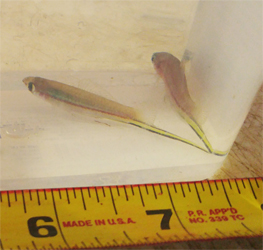 |
|
With
swordtail species, miniature, fast growing males will
occasionally
appear, referred to as "early maturing" males. In a 4-5
inch fish, such
as the X. alvarezi at
left, the early maturing males are only about 2
inches long, including the sword. These will develop a
gonopodium and
sword before their siblings, and you want to separate
them from your
population as soon as you see them, or your colony will
diminish in size.
The best males are those that mature latest and grow largest. |
 |
|
|
|
More Issues...
There is a dead fish in
the tank- Immediately remove the dead fish so that
you do not trigger an ammonia spike in the
aquarium. Then try to determine
the cause of that fish’s demise. Each death is an opportunity to
evaluate the tank and solve a
problem. Take advantage of the
opportunity to prevent further losses and improve the
tank
conditions, if possible. Any death
(other than old age)
provides you with information to possibly upgrade how you are
doing things, and is likely notifying you of a
problem or situation that may
need attention. Not all dead fish have a tale to tell, many do.
How long can fish go without eating? The
books will tell
you two things. Either two weeks, or, you can't starve a
fish, they will
die of an
opportunistic
infection before starving. We think of the fish as little
humans, but not eating is handled differently by our fish.
We don't eat, we starve, we
die. Fish can go for long periods of not eating, and though
certainly hungry, they will be active, and for
the first week or so they show
few ill effects, particularly if they had been well taken care
of previously. But compromises are at
work. Their immune systems are
weakening, and they become less able to fight off
disease.
When not fed,
Fry will be eaten., and
tolerance for disruptions and stress, such as swings in
temperature are
handled less well.
The result is that you may return after 10 days of
not feeding your fish, and
at first, though possibly looking thinner, they will
appear to have survived well. What will happen, however, is
that some fish will die over the next week or so from
opportunistic issues
that arise from the effects of being fasted, and a steep price
may not become clear until after they are
returned to their usual feeding
schedule.
When away, I have
the room checked and everyone fed at least every other
day. I will leave them for up to a third day without
feeding
with few ill effects. I know people that will leave their
fishrooms unchecked for up to 2 weeks,
but this will nearly always
result in
the loss of at least a few fish.
|
 |
|
|
| |
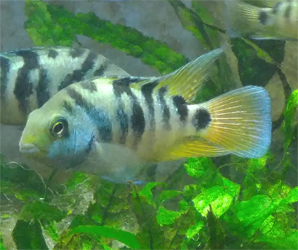 |
Fish
provided with consistent water
quality and good foods
will grow larger, show better color and
breed willingly. These
are the F1s of the cross between two
all blues, and
their spawns
should produce 25% blues - I have not grown out a spawn
of theirs
as of this writing (Jan. 2017). These are not hybrids,
but 5 years
of
selective breeding and using color mutations thrown from F1
from the wild, Honduran Red Points. I expect I am 2-4
years
from having the all blue cichlids for sale. These
however, will
need to be sold off as breeders are chosen, etc. If you
might
be interested in these one of a kind fish, email me at
selectaquatics@gmail.com , and I can contact you when any
become available. |
 |
|
|
|
Can Fish Tolerate routine use of salt? Most fish have no
problem living long term with a
medicinal level of salt - 1
tablespoon per every 5 gallons, and it will certainly suppress
disease. Some
advise against using salt with scaleless
fishes, but I have
known large, well run fish stores that have maintained that
level of salt in all their aquariums of fish for
sale. Overall, salt
is messy, is destructive to metals and
plants, and can be tricky to maintain at consistent
dilutions when
doing regular
water changes.
Here, we do not use it except to treat disease or when first
acclimating some species.
What is the best way to prevent disease? I have not used
Copper Safe, but it is said to be a replacement for Aquarisol,
which was excellent for
preventing disease when dosed with
water changes. Today, other
copper based disease preventatives
are still available. Using a
half or full medicinal level of salt will also help to prevent
disease. Otherwise, avoid wide
temperature swings in your
tanks (more than 2-3 degrees), maintain relatively
clean tanks
with regular water changes and an
appropriate
stocking level,
regularly removing any mulm that collects, and keep the
filter
mediums changed. By doing those
things you will see disease
rarely, if ever. And of course, use a
quarantine tank for 2
weeks before introducing any new fish
to your tank.
Does the placement of the tank matter to the Fish?-
Absolutely. And it becomes more important when you are hoping to
breed
a fish, or keep them long term.
Besides the usual advice to not put a tank in front of a window
or over a heater vent, far more subtle
influences come into play with
many species. Here, when a species does well, it is noted and
followed as to why - average
temperature, temperature
variations, amount and duration of
light, activity outside of
the tank, as well as placement near the floor
or ceiling. After many years of
keeping track of who does best where,
goodeids have gravitated
to the cooler alcove, where the
swords have done poorly. They moved to areas where some of the
catfish also do well. When
placing just a tank or two, look
for a location that provides
consistency and ability to see clearly into the tank, to keep an
eye on how the fish are doing. A tank
that is not examined at least
daily simply doesn't do well!
Can you catch disease from
your tank? In fact, yes, there is a type of tuberculosis you
can catch from working in a dirty
aquarium. Some facilities
encourage their employees to wear latex gloves when working in
their tanks. Though I do not wear
gloves when working in an
aquarium, and never have, I do not put my hands in the aquarium
when I have any open scratches
or cuts, and never crush snail
shells with fingers against the aquarium glass. (as you can be
cut and introduce bacteria).
I have worked in aquariums all
of my life, as have many I have discussed this with, and none
have ever become sick,
or known anyone that has.
However, it is possible, and maintaining a relatively
clean
aquarium while taking precautions to
avoid introduction of bacteria
through cuts and scratches are minimum precautions that should
be followed.
Can you eat the fish from your aquarium? - I have been
asked this more than once. My answer is based on what I have
been
told - I have not tried it. But
many of the fish we keep in our aquariums are eaten when caught
in the wild by the local populations.
Some are said to be good eating
- the oscar cichlid first comes to mind. But I am told that
aquarium maintained fish lack the muscle
tone and a lifetime of high
water quality, and both those
aspects affect the taste, texture and experience of eating the
fish you raise
in your aquarium. People have
told me that indigenous people will make tacos from the X.
helleri I maintain here. If you have eaten
a fish you raised in a home
aquarium, I would like to hear about it!
|
 |
|
|
| |
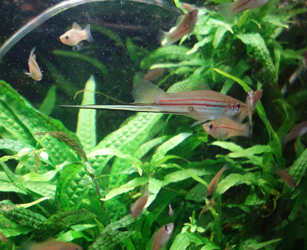 |
|
Every
fish has its own personality and needs that often
differs between species. These
X. mayae prefer living in
tighter quarters, are shy until they get to know you,
generally do not eat their fry, and show almost no
aggression
toward one another. Most other swords, particularly the
males,
will chase one another around and establish a clear
heirarchy
within a tank. Because of their need for feeling
secure, and
often living together in higher numbers, they are
provided with
fairly heavy filtration
and live plants. |
 |
|
|
|
The power went out! Now What?- When this happens, and it
will, unless you have set up tanks with special conditions, in
most
cases these freshwater fish
will be fine for a few days. The issues are
heat first, then
aeration, then
filtration (which can be addressed
through
water changes). If you
anticipate that the outage may take more than a couple hours,
split up any heavily stocked tanks into
smaller containers to give
greater access to air than when confined together in the
aquarium. Do not feed anything. If separated out
into bodies of water sufficient
for them, they can last for long periods, particularly when
doing daily 50% water changes and possibly
feeding very lightly. Fish last
in boxes when shipped for up to a week, and often longer.
Provide an airstone if possible. Often the
biggest problem is when the fish become
chilled. The fish may have appeared to do well, as none had
died during the outage. The
issue is that the fish were weakened by the
experience, and may catch
opportunistic
infections in the
upcoming 1-2 weeks.
Though not appearing sick when the power
resumes,
introducing a 1/2 medicinal level of salt
and watching the tank closely following
an
incident may be required to recover past the effect
of the outage.
Does the size of the tank matter to the fish?- Besides
the obvious issues of the size of the fish and tank size, one
species of sword,
for example, the
X. mayae,
likes being kept at higher density levels in slightly smaller
tanks than the other swords carried here. Others
are far more territorial and
prefer a less highly stocked tank. Many of the
goodeids do best
in 29 gallon tanks, and for example, a fish
like the the
C. lateralis does
not always do well when given a 55 gallon tank. More tank is not
always best, and dividers are made for
most of the tanks here. They
are used often to separate pairs or maintain small pops of
dissimilar species. This way the fish benefit
from the stability of a larger body
of water, but are still in a smaller space so that
food is
easily accessible.
This concept is the strength behind
central
filtration of multiple tanks.
Yes, filtration maintenance is easier when there is just one big
filter to clean, but at the same time, a
disease or
problem is distributed through the tanks being served by the
system. But some
fish will show an improvement in health and
breeding when provided with the
feel of access to a larger body of water that a central
filtration system provides.
How long will fish live?- Most of the livebearers will
live for 2-3 years, some will go to 4. A guppy generation time
is considered to
be 4 months. The swords,
platies and mollies have a generation time of approximately 8
months, and they generally live up to about
4 years. Some of the
Goodeids will routinely die in the
spring of their third year. Danios will live a similar length,
but some,
such as the Giant Danio will
occasionally get to 4-5 years old. Some barbs and tetras will
live up to 5 years, and a few species
may live up to 8-9 years. With
Cichlids you are dealing with fish that live longer - often up
to 10 - 12 years. Some of the catfish
will live a long time as well, such as
some species of Synodontis that will live up to 20 years,
and others
can live far longer.
|
 |
|
|
| |
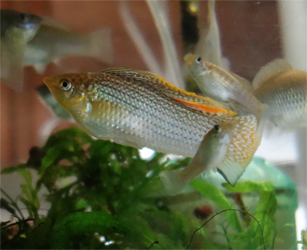 |
Most fish
will survive long term with a once a day
feeding.
However, some fish are grazers, with shorter digestive
tracts,
and they do best when fed small amounts throughout the
day,
as opposed to big once or even twice a day feedings.
The
velifera is an
example of a fish that is that way. See more
on keeping the P. velifera
HERE.
Fish benefit greatly when a second feeding per day is
added,
improving their rate of growth, color, and both
frequency and
eagerness to breed.
|
 |
|
|
|
How many times a day should
I feed?- All of the fish carried here must be fed at least
once a day. Once a day can be
adequate for most species, but
is minimal. Through trying a variety of feeding schedules, I
have found improvement in overall
fish health, color,
growth and
breeding when a second feeding is introduced
is substantial. Adding a third feeding, particularly
if done in the evening, when a
morning and noon feeding is possible, will introduce another
jump in growth, appearance and
breeding. However, the jumps in
overall fish health do not seem to continue much after a third
feeding per day, with the exception
of those fish that are grazers, fish
that should be fed throughout the day, such as
the
P. velifera. Here the
velifera are fed small
amounts 5-10 times per day for maximum
growth and breeding.
How long is Dry Food good
for?- It's best to assume dry food retains its freshness, in
an airtight container at room
temperature, for about 90 days,
and up to 2 years if kept in a freezer. Storing the food in
airtight containers in a refrigerator or
freezer, protecting it from the humidity
of a fishroom, will extend its life. One way to test the food is
to smell it. If it has no smell,
or smells slightly rancid or
stale, it is no longer good! |
 |
|
|
| |
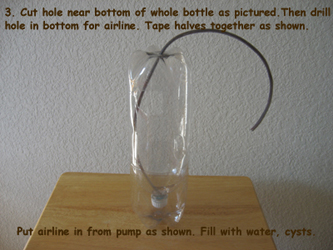 |
|
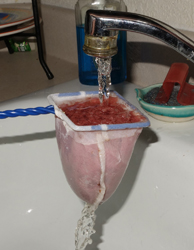 |
|
A
great part of the hobby is the opportunity to
make stuff and do things for your fish that can
be made cheaply, or only provided for them when
you create it. One of the most common is the 2 liter
pop bottle brine
shrimp hatcher, and how to do that
is HERE. The pic
near left is rinsing ground
beefheart,
to be frozen into ice cubes and fed to the fish. |
 |
|
|
|
Are live Foods really necessary? - For some species, yes.
For the fish sold here, a few should have their diet
supplemented regularly with
live foods, as they need the boost for growth and
reproduction.
Without baby brine shrimp for
new fry, for
example, you may
see losses, and fish simply do not grow as robust as they should
on powdered dry food
alone. When
live foods are not
an option, many quality frozen foods also do an excellent job.
For convenience and keeping
relatively fresh live food
available, large batches of BBS
(Baby Brine shrimp) are hatched then quickly frozen in ice
cube
trays. They are then fed as needed
regardless of whether or not a hatch of cysts is in process.
What are the best Live foods?- With respect to providing
the broadest nutrition, easiest to raise, digest and known to
show the greatest results, when
fed to increase breeding and growth rates, the best live foods
are: Newly hatched baby
brine shrimp, followed by red
worms (Chopped, for adult fish), followed by
black worms
(Live), blood worms (Live or frozen),
daphnia (Live or frozen),
vinegar eels (For the smallest fry), and then mysis shrimp
(Frozen). I am working with a species of
white
worm currently that is prolific, and does not
require refrigeration, showing great results with many of the species
here.
Microworms are not used here
currently, but are used by many instead of vinegar eels for the
smallest fry.
What are the easiest live
foods to raise? - After trying just about everything (but
not mosquito larvae!), there is a
live food
that is hands down the easiest
to raise, you can raise them in large numbers, they don't carry
any aquatic pathogens, don't bite,
and can be left for long
periods without being fed. They are so nutritious that fish can
be maintained on just them alone. And that
live food are
red worms. The
drawback? They are best for slightly larger fish, and you have
to cut them up to feed them to your fish,
and many find that tough to do. Find how to obtain, keep, raise
and breed them HERE.
2nd easiest -
Vinegar Eels-
For egg layer and small livebearer fry, they are about the size
of microworms, and when a culture
bottle of them is set up, they
can go 5 months without being disturbed - no feeding, nothing -
and they will be fine, yielding
a large harvest whenever you
choose to feed. At 4 months you simply start new cultures.
3rd easiest-
Baby Brine
Shrimp - With the making of a 2 liter bottle
hatcher, you
can produce daily live baby brine shrimp with
the purchase of viable brine
shrimp cysts. A pound can that sat in a friend's hot garage for
any period of time, or hung on a
hook on a pet store wall at
room temperature may not hatch for you. Cysts should be
refrigerated or frozen as soon as they
are obtained. The best way to
obtain brine shrimp is to purchase a 1
lb. can from a vendor such as
Brine Shrimp Direct.
Keep
the
opened can refrigerated. It is a fair initial expense ($40-50),
but a pound will last you a long time.
Can I make my own Food? - Yes, but you may decide it
is not worth the effort. Fish food recipes, such as those
published by
Dr. Gordon going back to the
1930's were often prepared by hobbyists at home. Some
foods can be done relatively easily,
such as
Beefheart. However, when
combining the ingredients required for those older legacy
recipes, you will need to deal
with the same issues that commercial
preparations have solved. There are hobbyists with quality food
drying equipment
producing excellent
quality foods, and can be found selling these specialty foods on
the internet.
|
 |
|
|
| |
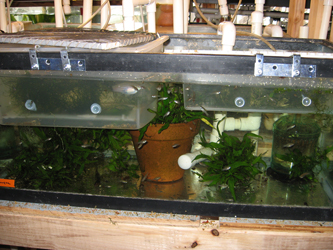 |
|
Plastic
shoebox style containers are used as
breeders here by
cutting out the majority of one long side and the
bottom, then
gluing in a fine waterproof mesh over the openings so
that
water can flow through the containers. Then, make-shift
handles
are fashioned from hardware pieces and connected to the
shoeboxes with electrical ties. Marbles are glued to
the sides
to keep it away from the aquarium glass so that fish do
not
get stuck behind them. |
 |
|
|
|
Do Net Breeders Work? -
For some species, yes, for most species carried here, no. But
they are used routinely here to raise up
new fry. The reason is that at
5-6 inches square, they are generally too small for most fish
other than guppies and the Tiger Limias.
They are not to be
considered for the larger swordtails, and with the
Ameca
splendens, gravid females put into a breeder
will often abort their brood,
and drop all of them within a day or two of being put into the
breeder. The best way is to set up
a 2 gallon "Critter Keeper", or
a 5 or 10 gallon aquarium. bare bottom, heavily
planted, with a
sponge filter (So that
fry
are not sucked up, and can feed
from the surface), and a cover to prevent the female from jumping.
Then, as soon as you see that
she has dropped her brood,
remove her and the majority of the plants.
Then raise the fry up separately until old enough to fend
for themselves before being put
in with the adults.
Greg
Sage
selectaquatics.com
selectaquatics@gmail.com
|
 |
|
|
|
|
|
|
|
|
|
|
|
|
|
|
|
|
|
|
|
|
|
|
|
|
|
|
|
|
|
|












